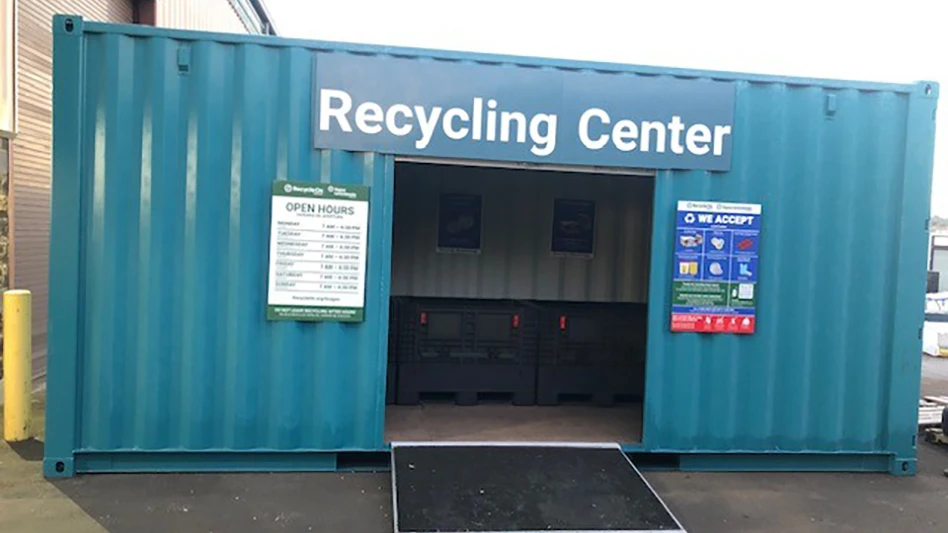LARGE U.K. RECYCLED NEWSPRINT MILL FORMED
Mountains of old newspapers and magazines are being turned into high-quality newsprint in one of the most ambitious recycling enterprises launched to date in Britain. A paper mill in Kent, southern England, has recently undergone massive development, and now has the capacity to produce 370,000 tonnes of newsprint annually from recycled ONP and OMG.
The project is expected to result in a significant increase in U.K.-produced newsprint, about a third of which would be destined for export. The resulting newsprint is designed to be especially clean and bright in order to meet the current demand for four-color printing.
Raw materials for the Aylesford Newsprint plant come from used publications which have been deinked and cleaned in a new preparation plant, and additional tonnage is slated for collection through joint ventures with local municipal authorities and other groups. The Aylesford project will help meet a British Government goal of 40 percent recycled content in newsprint by the year 2000.
PRINS SIGNS ON TO BRONX PAPER RECYCLING PROJECT
After years of struggling with a variety of obstacles, the Bronx Community Paper Co.’s planned paper recycling complex in the South Bronx, N.Y., came closer to reality when Prins Recycling Corp., Fort Lee, N.J., signed on as the operator of a state-of-the-art scrap paper sorting facility on BCPC’s Harlem River Yard site.
BCPC is currently negotiating with several companies to finance and operate the paper mill, and expects a letter of intent for the mill to be signed before the end of the year.
The planned facility will process up to 300,000 tons of secondary paper annually for recycling at the adjacent mill – fiber which is currently processed outside the city.
BCPC representatives say about 700 permanent jobs will be created within the city for skilled and semi-skilled workers, many of whom will be residents of the South Bronx.
Under the agreement with BCPC, Prins will commit significant equity for construction of the sorting plant and will raise the remaining funds needed for construction. Prins will also operate the plant.
The BCPC is a joint effort of the local Banana Kelly Community Improvement Association and the Natural Resources Defense Council.
RECYCLING TRITIUM FROM OLD TELEPHONES
AEA Technology’s Recycling and Waste Management division at Whinfrith in southwest England has been tasked by British Telcom to recycle Trimphones that are no longer useful. The Trimphone telephone was launched in Britain in the 1960s and had a dial that glowed in the dark. It was illuminated by a gaseous tritium luminous device – a small glass tube coated on the inside with phosphor and containing a small amount of tritium gas, a mildly radioactive form of hydrogen that caused the phosphor to glow. Around 2 million of the Trimphones were made.
AEA’s main goal is to recovery and recycle the tritium. After the dials are removed from the phones, a robotic process further dismantles them. In a second phase, the tritium will be removed from the stored and separated gaseous tritium luminous device at a plant currently being built by AEA that will be operational in 1997.
RECYCLING TIRES INTO POLYURETHANE PARTS
Using a patented process to treat ground rubber from discarded tires, Urethane Technologies Inc., Santa Ana, Calif., says it can use finely ground rubber as a cost-effective filler in polyurethane bicycle tires, industrial wheels, shoe outsoles and other products.
The findings were presented in a paper titled "Advanced-Technology Tire Recycling System For Improved, Cost-Effective Polyurethane Parts" at the Polyurethanes ’95 Conference recently held in Chicago. Together with an innovative, proprietary blowing system developed by UTI, the tire recycling technology has "the potential to open sizeable new markets for polyurethane systems," says John McNeill of UTI.
Earlier attempts to use ground crumb rubber as a filler in high-performance polyurethane systems has had limited success, according to McNeill, "because of problems getting the rubber to bond well with the polymer." UTI’s post-treated crumb rubber is trademarked under the name Stermic.
MIXED CULLET FOR PAVING PROJECT SUPPLIED BY ENSLEY
Forty-five tons of mixed cullet, unsuitable for glass manufacturing, was recently used by the Ottawa Seneca Sandusky Solid Waste Management District, Ohio, as an additive to asphalt for the paving of a one-mile length of roadway. The cullet was supplied by The Ensley Corp., North Canton, Ohio.

Explore the January 1996 Issue
Check out more from this issue and find your next story to read.
Latest from Recycling Today
- US Steel to restart Illinois blast furnace
- AISI, Aluminum Association cite USMCA triangular trading concerns
- Nucor names new president
- DOE rare earths funding is open to recyclers
- Design for Recycling Resolution introduced
- PetStar PET recycling plant expands
- Iron Bull addresses scrap handling needs with custom hoppers
- REgroup, CP Group to build advanced MRF in Nova Scotia





